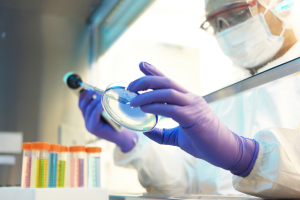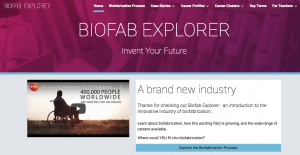 Mary Stewart, education and workforce director at BioFab USA — one of 16 Manufacturing USA institutes supported by federal dollars — described herself as a “hands-on” learner. As a kid, Stewart said, she was always taking things apart and “trying” to put them back together.
Mary Stewart, education and workforce director at BioFab USA — one of 16 Manufacturing USA institutes supported by federal dollars — described herself as a “hands-on” learner. As a kid, Stewart said, she was always taking things apart and “trying” to put them back together.
Stewart identified a direct connection between the skills she formed working in her grandfather’s garage and those that guided her career in biofabrication. But she didn’t make this connection — between inherent curiosity, skills and a career — until much later in life.
“When I was a kid, I didn’t know what career and technical education (CTE) was. Or maybe I did. But no one told me about all the cool things kids were learning and doing in those classes.” Now Stewart works as a CTE biotechnology teacher. And she believes CTE classrooms offer an ideal educational structure to introduce students to career opportunities in biofabrication.
CTE students learn career skills like lab safety and time management. And they engage in hands-on, problem-based learning related to the workplace. Plus, biofabrication is multidisciplinary with a variety of career opportunities. “No matter what their interests are, students in manufacturing, health science, biotechnology or engineering can all find careers in biofabrication,” Stewart said.

What is biofabrication?
Biofabrication, a general term, describes the large-scale manufacturing of human tissue from organic or synthetic sources. Biofabrication leaders, like Dean Kamen (inventor of the Segway), envision a world where hospitals will grow new organs for patients using their own cells.
While many people still view organ and tissue manufacturing as science fiction, the reality is that very soon the biofabrication industry will need skilled technicians. The biofabrication workforce will require career pathways that don’t even exist today (e.g., tissue manufacturing technician). In fact, according to Sam Johnston, director of postsecondary and workforce development at CAST:
For every Ph.D. in an emerging manufacturing field like biofabrication, a global workforce needs seven STEM technicians.
To support educators’ awareness of biofabrication and ultimately increase the future workforce, Stewart and a collection of biofabrication companies collectively known as the Advanced Regenerative Manufacturing Institute (ARMI) reached out to the educational nonprofit CAST. They wanted to equip school counselors and CTE educators with resources for career exploration in the field of biofabrication.
“We wanted to work with CAST because they were committed to the concept of co-design,” said Stewart. “And they have expertise in utilizing Universal Design for Learning (UDL).”
Built upon the “universal design” movement in architecture and product development that have made spaces and information more accessible to individuals with disabilities (Mace et al, 1997), UDL research and practice focuses on instructional innovations and interventions that address learner variability (Meyer, Rose >amp; Gordon, 2014). UDL is specifically referenced in all federal legislation that governs education. Most recently the Strengthening Career and Technical Education for the 21st Century Act (Perkins V) highlighted UDL as an allowable use of funds to:
- Support special populations
- Design and utilize accessible technology
- Act as professional development for educators
“We needed to find a way to help CTE educators by creating simulated WBL opportunities, creating more extended or independent learning opportunities, and increasing dual enrollment opportunities,” Stewart said. She added that the timing is right for this kind of support since, “our future career force is in junior high right now.”

Reach every student
The idea of designing with CTE students and educators (co-design) was essential to the success of the project. Stewart wanted to ensure that the solution would appeal to young people and answer their questions about career and work. Based on feedback from co-design meetings, a tool — BioFab Explorer — was designed to align with CTE career clusters. Collaborators developed a Teacher Resource page, and they designed activities to make explicit connections between a variety of CTE programs — such as manufacturing and engineering — and biofabrication careers.
Students connected most to biofabrication through patient stories. “Often kids care about these issues because they have direct experiences with a family member or friend. We wanted to design our solution in ways that would help them understand how innovation happens to solve big scale societal problems and that directly connect to their own education, lives and careers,” explained Johnston.
BioFab Explorer
BioFab Explorer is a free open educational resource (OER). The content includes:
- A series of videos profiling diverse career paths into biofabrication
- Case stories of individuals positively impacted by a biofabrication technology
- Activities that teachers, counselors or students working independently can use to explore career pathways in biofabrication
As an OER, videos and other content on the site can be repurposed, reused and recycled by all educators.
Teacher and student resources can be used to increase career awareness in a variety of CTE programs. Enrich students’ understanding of this emerging STEM field. Educators, use the resources in this tool to develop high-quality work-based learning experiences. as well. Industry interviews and activities introduce students to the world of work in authentic simulations.
Recently, a high school senior from Pinkerton High School in Derry, New Hampshire, contacted CAST. They expressed interest in veterinary science but, after an experience with BioFab Explorer, wanted to learn more about biotechnology.
Learn more about BioFab Explorer.
With questions, contact Amanda Bastoni, educational research scientist at CAST.






